A void noise. A metallic noise. Like a bell tired of ringing. “In the name of mother, daughter and sisters all, take and drink, this is my body offered in ruins for you”.
This is how the live performance by the students attending the course in Artistic Anatomy at Cittadellarte‘s Accademia Unidee welcomed its spectators: inside the rooms of a disused industrial archaeology building in Biella which, with the charm of the ruins of time, knows how to evoke, to create the illusion and to ask to be inhabited again. Between the silence of the peeling walls and the flowing of the river Cervo, at the foot of the Chiavazza Bridge: “This is our blood, shed in the name of our sisterhood,” continues the voice, coming ‘from beyond’, from the invisible planes of impotence “remember your sisters who have fallen asleep in the hope of resurrection”. A woman crawls painfully, little by little, from the upper floor, her body torn; wrapped in white fabrics, like a fallen angel, she reveals her inner feelings, but it is her fiery red, bloodshot eyes that speak now.
Hovering between the sacred and the profane is the live performance of Luisa Mertina, a 3rd year student of Sustainable Fashion Design. The observers, at the same time attracted and repelled, are powerfully transported to the other unknown rooms of the building, her body is found with her hands immersed in vats filled with her own blood and her eyes giving a penetrating look: “This is my blood shed for you. I will not be a wife nor a mother. I want to be a woman. I want to bleed free. I do not want to abide by your rules. Of your modesty and this shame, I wash my hands”. Tracing marks and footprints on the half-plastered walls of the UNIDEE Space, the performer continues to inhabit the space in the midst of the public, abandoning it to the encounter of another situation.
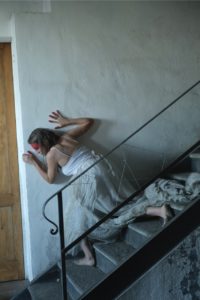
This time the atmosphere is faded indigo, like the satin dress of the figure in the centre of the new room. Absorbed in observing her own face, reflected on a small mirror held in her hands, a woman sitting in her intimate space is busy putting make-up on her lips, which are as red as the lighter she lays on the table.
“You’ll never find anyone better than me again. Are you sure you’re seeing your friends? Where are you going with that make-up on? I am your boyfriend. You are mine”. A forcibly serene male voice, from the back of the room, addresses these words to her. The atmosphere intensifies, in tones and reactions, shaping a situation unfortunately already familiar to many in the audience. Shredded photographs, burnt letters, charged eyes, backs to the wall and endurance held to the limit of a persistent deafening silence. “Just don’t piss me off,” the boy continues undaunted, “I don’t treat you badly, I love you”. A door is slammed and the silence is broken: cries of pain, but only for a few moments, the last ones. The performance is carried on by the audience who, petrified, remain to watch what remains of life’s atrocities.
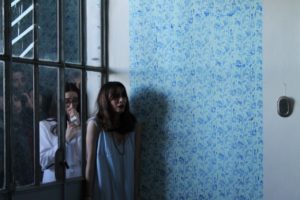
“Welcome into Me!” reads a sign at the entrance of a space from which a faint warm light emanates. As each spectator continues to get lost in the labyrinthine spaces of the abandoned former factory, everyone is here invited to witness the discovery and encounter of the former self. Like reopening the diary you wrote as a child, recalling the empathy you felt for those characters narrated in the author’s pages, in this room the performer comes back alive in the reflected scene of a monologue in the mirror, which is not really a monologue. “Talking to the ex. The ex of myself” you can read among the various messages posted on the walls. The performers here are the different Alvaro Werners reflected by the only Alvaro Werner. They all wear their grandmother’s green kimono with red roses, leather heels and sunglasses while sipping white wine. “It’s a choice, love. Make your choice,” they tell each other from one dimension to the other, “know that I am you. I am the choice you make in your life. Do not be afraid, come. Life out here is beautiful. Go out, live, don’t exist. You are here, we are together, you live in myself”.
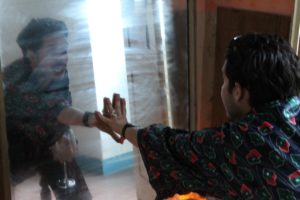
Meanwhile, a dance between two souls, marked by the attempt to hide a sharp blade, evolves more and more into a figurative struggle between two human introspections. Within these walls, amidst piles of moss, mannequins and dust on Persian carpets, Filippo Panico, a 1st year student of Sustainable Fashion Design, performs conceptually with the destructive and creative part of himself; and with ‘betrayal’, embodied by a black figure which will lead him to surrender in the search for the light of ‘trust’, personified by a female body in white robes. Through the use of colours, symbolic costumes and thanks to the collaboration of Sara Rognoni and Francesca del Pizzo, the performance proposed by the young WZRD, stage name of Filippo Panico, sets in motion a story of emotions and a tale of the relationship that can exist between two contrasting behaviours.
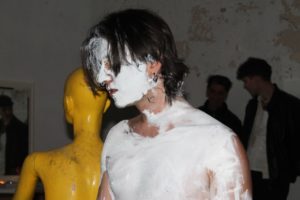
‘Dreams’, ‘Hope’, Love’, ‘Courage’: these are some of the words that, like in a stream of consciousness, are jotted down on a white sheet of paper by a darkly dressed body, standing in a small dark room. It is the transposition of the mosaic of thoughts arisen in the mind of a woman tied to a chair, unable to move. This is the performance of Natalie Terezova, a 1st year student of Sustainable Fashion Design, realised in collaboration with Gabriel Croso, a 2nd year student of Visual Arts for Social Sustainability.

In the course of the itinerant experience which was the event held at Accademia UNIDEE’s home, it happened to everyone in the audience, at least once, to come across the extended spider’s web of the student Melek Bacha. Inspired by Dostoevsky‘s classic “White Nights” (1848), the young performer weaves and unweaves webs, erecting walls of yarn that become projections of a personal ‘shield’, supported by anxieties and torments. “It is the transposition of a nest I created over time for me,” the 1st year student of Sustainable Fashion Design said to us, “a den from which I am flushed out by myself, cutting, in an inverse process of construction, that thread that connects my past, my present and my future”.
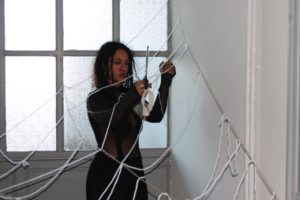
These were the individual performances of Cittadellarte’s Academy’s students which, between 6:00 and 7:30 p.m. on 16 April, alternated in the empty volume of the UNIDEE Space through what was defined by their teachers, Verena Stenke and Andrea Pagnes, and the students themselves:
“A journey of our own, dynamic,
To make fragile walls and empty, disused rooms come alive
At least for one day, one hour,
The time of a breath”.
The teachers of Accademia Unidee’s course in Artistic Anatomy Verena Stenke, a German artist, and Andrea Pagnes, a Venetian artist and writer, founded an artistic duo in 2006, under the name VestAndPage, to explore their artistic research with performance art and film on an international level. VestAndPage’s artistic practice is psycho-geographically conceived in response to the natural environment, social contexts, historical sites and architecture, constantly seeking a poetics of relationships with their actions. “We work on narrative development,” said Verena Stenke, “through collaboration, performance and storytelling. On these aspects we were able to work alongside our young students, inspiring them”.
Verena and Andrea are the founders and directors of the Venice International Performance Art Week, and their publications, featuring their poetic writings, have been translated in different languages. After the performances in the UNIDEE Space, we listened to the words of the artist and teacher Andrea Pagnes about the course and the project he completed with the students (see full list of their names at the end of the article).
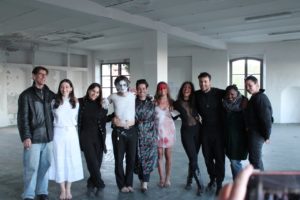
“Prior to the performance project, we curated, together with the students, a pathway to search for one’s own emotional power through what is called ‘creative writing’. The inner feeling is to be understood as a lump of clay in our hands, like a body. By starting to mould it, one can extract performative actions, aware that these can be further transformed depending on the space in which the emotional powers are performed. One of the fundamental elements in performance art is the relationship which is established with oneself, with another performer, with the audience and with the body in the space. The void is also a body. That is why the name of the course is ‘Artistic Anatomy’, because it is based on the analysis of all those theories related to body, space or memory, to name but a few. For us, the challenge is to keep all these concepts and bodies in action, from day one. ‘Holding the space’ means wearing it, protecting it, and thinking that by going through it, with one’s own action, one can guard and express their artistic and creative potential. This project proves how space, as a body, has interacted throughout its development. And this is where we have come, back to the question ‘What spaces in the city would we like to see regenerated and to what purpose?'”.

